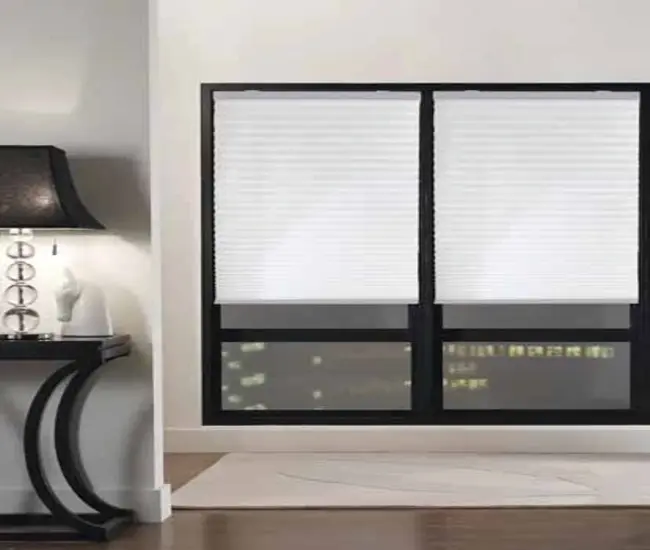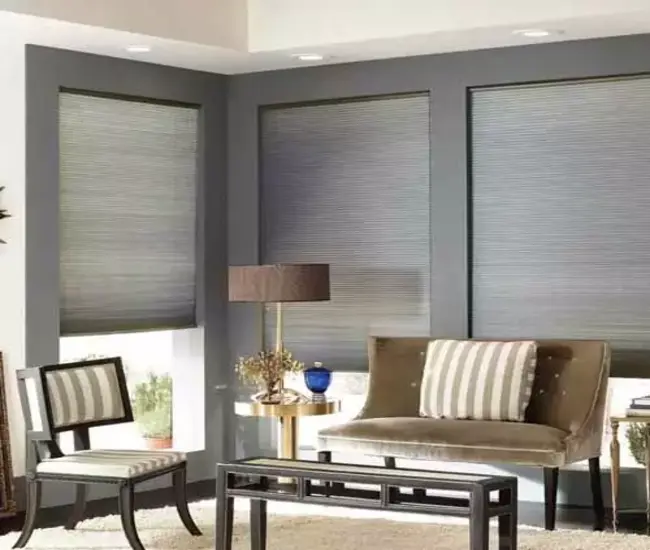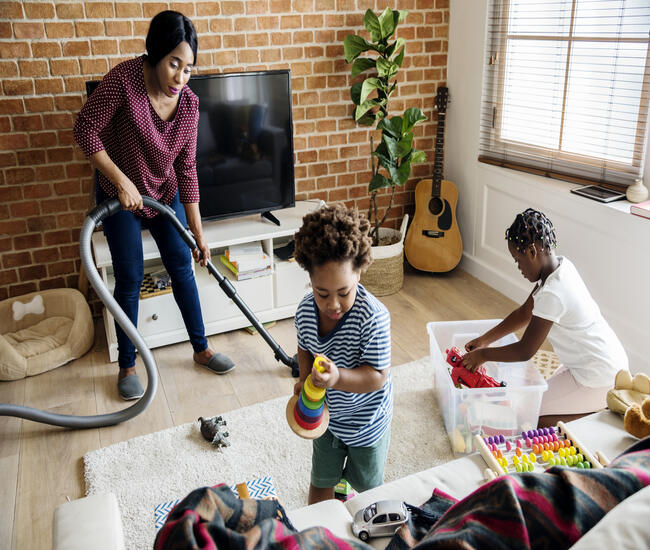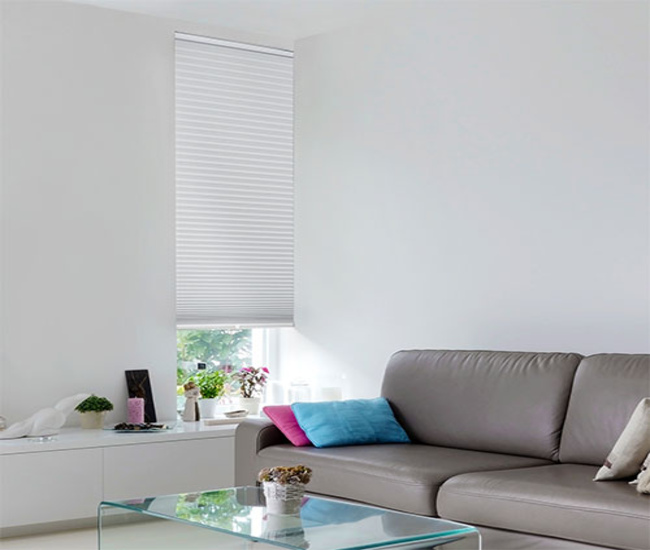Not savvy on the nuances of cellular and pleated window coverings? Wondering if cellular shades or pleated shades will better serve your needs for light control, insulation, privacy, style, and convenience? Read this primer on cellular shades vs pleated shades and get a little pro assistance on deciding which design is right for your home.
Both cellular and pleated shades provide excellent light control and privacy, with the honeycomb shades providing superior insulation than the pleated ones. If your home is in an extreme climate, select cellular shades to beat the heat and cold. If you want more natural light, choose a pleated shade with lightweight fabric.
For those who prefer total darkness at night and during the day, go with a heavy double cellular fabric or add a blackout liner on the honeycomb blinds.
Cellular shades are a bit costlier option and are difficult to clean, but they offer the best possible insulation, more privacy, and better noise cancellation. On the other hand, pleated shades are more affordable, easier to clean, and come in a huge variety of fabrics, but they are less insulating.
A top down bottom up cordless cellular shade will cost you $98.86 (£77.20) for a 48” (4 ft) W x 48” (4 ft) H window, while you can buy an essential cordless pleated shade for as low as $77.21 (£60.29) for the same sized window, saving you at least $21.65 per product! If you buy 10 pieces, the savings will be $216.5!
However, that extra amount is worth it, as cellular shades will save you $100’s per month on your home’s energy bills. The double cell design of honeycomb blinds offers even better insulation.
To help you in the decision-making process, here’s a comparison and contrast of pleated shades and cellular shades with pros and cons of each.
Similarities between Cellular and Pleated Shades
- Both honeycomb and pleated shades are popular modern choices for decorative appeal, light control, and energy efficiency.
- They are just simple, easy window treatments.
- Each comes with child-safe cordless, top down bottom up, and motorization options.
- Pleated blinds look the same as cellular shades from the front, but they do not offer the highly insulating honeycomb design.
- Both are available in lots of sizes to fit any window, from very small to extra large.
Differences Between Pleated Shades and Cellular Shades
Pleated shades and honeycomb or cellular shades are two of the most popular types of window treatments on the online market.
Both offer lots of benefits, but they also have some key differences that you should keep in mind when making a decision about your future window treatments.
There are many factors to consider when choosing window treatments for your home. Two of the most popular options on the market are cellular shades and pleated shades. But which one is right for your home, cellular or pleated?
Here are the key differences in the structure and function of cellular and pleated shades.
Pleated Shades – A Single Piece of Pleated Fabric

Pleated shades are made from a single piece of fabric that is folded into a series of pleats. This gives them a clean, streamlined look that can complement any decor.
Pleated shades also provide some insulation, helping to keep your home cool in the summer and warm in the winter.
Cellular Shades – A Series of Interconnected Cells

Cellular or honeycomb shades, on the other hand, are made from a series of interconnected cells that trap air inside.
This design makes them one of the most energy-efficient window treatment options available, as they can help to regulate temperature and reduce your energy costs.
Saving on Energy Bills vs Preferring Curb Appeal
If you’re looking for an affordable window treatment that will provide insulation and help you save money on your energy bills, cellular shades are the way to go.
But if you prefer the look of your window treatment or need a more budget-friendly option, pleated shades are a great choice.
Whichever type of shade you choose, be sure to measure your windows carefully before making a purchase to ensure a perfect fit and easy, hassle-free installation.
Pros and Cons of Cellular Shades
Window coverings are a great way to add functionality and decorative appeal to your windows and overall interior décor. Pleated shades are a popular option because they are relatively inexpensive, but cellular shades are another option that you may want to consider.
Here are pros and cons of cellular shades (or honeycomb blinds).
Pros
Better Insulation and Energy Efficiency
The design of honeycomb/cellular shades consists of two layers of fabric with pockets of air in between, which traps air and makes them very good at insulating your home.
Blocking Out More Light
The cellular shades also do a great job of blocking out light, so they are perfect for bedrooms and other rooms where you want to create a blackout or 100% dark environment. That’s why they are also called room-darkening shades.
Adjustable Light Filtering

The cell structure of cellular shades allows for adjustable light filtering, providing privacy and reducing glare. The double cellular design also comes with a light filtering option.
Durability
Cellular shades are made of durable materials, which makes them a long-lasting window covering option.
Style and design Versatility
They are available in a wide range of colors, fabrics, and opacity levels, making them suitable for a variety of interior décor styles.
Improved Acoustics
The cellular structure of the honeycomb shades can also help reduce outside noise, providing a quieter environment inside your room.
Cons
Expensive
The downside of cellular shades is that they can be more expensive than pleated shades, but the extra cost may be worth it if you are looking for the best possible insulation and light-blocking capabilities.
Difficult to Clean

The cellular compartments of the shades collect dust and dirt, making it difficult to clean.
They’re Not 100% Sound Proofing
While cellular shades do dampen sound from the street better than pleated shades and other window treatments, they do not provide 100% sound proofing.
Pros and Cons of Pleated Shades
Pleated shades are a popular window treatment option for many reasons, such as their ability to control external light, provide privacy and UV protection, improve energy efficiency, and enhance the style and aesthetic of your space. Compared to honeycomb blinds, pleated shades are more aesthetically appealing and easier to clean and maintain. But they do have some drawbacks.
Below are some of the advantages and disadvantages of pleated shades.
Pros
Lots of Custom Options to Choose From
They are available in a variety of materials, colors, and patterns, making it easier to find an option that suits your style.
More Affordable

Pleated shades are more budget-friendly than cellular shades, making them a better choice for budget-conscious consumers.
Cordless cellular shades typically cost between $46 (£35.96) and $190 (£148.51) for a window measuring 18” (1.5 ft) W x 24” (2 ft) H to 72” (6 ft) W x 84” (7 ft) H. On the other hand, the average price of cordless pleated shades ranges from $44.87 (£35.04) to $129.64 (£101.23) for a window measuring 18” (1.5 ft) W x 24” (2 ft) H to 72” (6 ft) W x 84” (7 ft) H.
If you need a more affordable option, go with pleated shades. If you need more insulation and privacy, go with cellular shades. Consider your budget and your needs before making a decision.
Light Control
Pleated shades can control the amount of light sailing into the room, providing privacy and reducing glare.
Easy Operation
Pleated shades can be easily raised, lowered, and adjusted using a cordless mechanism or a remote control, making them a convenient-to-use window treatment option.
Space-saving Design
When raised, pleated shades fold neatly at the top of the window frame, taking up minimal space. This makes them a good option for small rooms or spaces with limited window clearance.
Cons
Less Insulation
Pleated shades don’t offer as much insulation as cellular shades, so they may not be the best choice for homes in colder climates.
Collecting Dust and Pollen
Like cellular shades, pleated shades are also likely to collect dust and pollen, so they may need to be cleaned more often than other types of window treatments.
Overall, pleated shades are a versatile and affordable option, but they may not be the best choice for everyone.
Are Cellular Shades Better Than Pleated Shades?
It depends. Pleated shades and cellular shades are both popular window treatment options, but they each have their own advantages and disadvantages. The right choice will depend on your budget, design options, need for insulation and noise cancellation, and other personal preferences.
If you are looking for a huge variety of fabrics to fit nearly any room or design scheme, choose pleated shades. On the other hand, if you need the best possible insulation against summer heat and winter cold, go with a cellular option.
Pleated shades are more affordable window treatments than cellular shades, but they provide less insulation and energy efficiency. Cellular shades are more expensive, but they’re better at cutting down on your energy bills.
Both pleated and cellular shades provide excellent light control, but honeycomb shades provide more privacy and noise cancellation.
If you are looking for a budget-friendly option, go with pleated shades, as they are more cost effective.
Finally, the decision between the two window treatment types depends on your budget and the requirements of your room or home.
Where to Buy Cellular or Pleated Shades at Best Prices and Discounts

Where to find the best cellular or pleated shades
If you buy new cellular or pleated shades at Affordableblinds.com, you’ll get:
- Up to 70% discounts
- Free Shipping throughout the contiguous United States at no cost to you
- 110% best price guarantee.
- 100% Worry-Free Fit: We’ll take up part of the cost to get your problem resolved, if you miss-measure your window.
- A Free Lifetime Guarantee
- 100% Satisfaction Guarantee with 5-star customer care
- Free Consultancy (Measuring, Installing, Choosing Right Product)
Summing Up
If you’re looking for a window treatment that will help you save money on your energy bills, cellular shades should be given preference over their pleated counterparts.
On the other hand, if you prefer the look of pleated shades or need a more budget-friendly option, pleated shades are a great choice for your home’s windows.
Nevertheless, after choosing your desired window treatment, be sure to measure your windows carefully before making a purchase to ensure a perfect fit.
FAQs
Are pleated shades still in style?
The answer is yes. Pleated shades are one of the most stylish window treatments ideas, offering a contemporary and sleek look to make your room feel updated. Functionally, they let in just the right amount of light without compromising your privacy. Also, they have an insulating effect to increase the energy efficiency of your home.
Are pleated blinds any good?
Yes! Pleated blinds can help improve energy efficiency in any space, as their honeycomb construction with air-trapping pockets can provide a highly effective insulating effect. Pleated window blinds are one of the most attractive and practical type of blinds available. They look as good on large windows as small ones.
Are cellular shades still in style?
Yes! Cellular shades still remain in style because of their tremendous insulating capability and versatility. You can hang them on every window throughout your home with or without a liner. Cellular or honeycomb shades are inherently energy efficient and can still contribute to a more comfortable indoor environment.
What are the drawbacks of cellular shades?
One major drawback of cellular shades is that they are difficult to clean correctly. The cellular construction that gives them all their power can also collect dust, so they will need more frequent cleaning. Secondly, they are more expensive and have a shorter lifespan than pleated shades.
What is the difference between honeycomb and cellular shades?
Honeycomb shades and cellular shades are the same thing. “Honeycomb” is another name for cellular shades, because of their defining honeycomb construction. The honeycomb construction can be two-layered or double cellular.
Need More Help?
Still unsure which is better for your unique functional and aesthetic needs: cellular shades or pleated shades? Contact our professionals using 24/7 live chat or give us a ring at (800) 863-6109 for expert advice and a custom solution.
